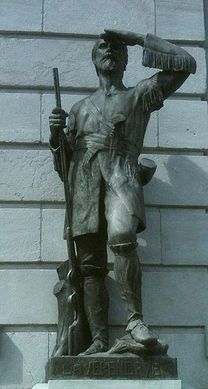 Statue of Pierre La Vérendrye in Quebec
Statue of Pierre La Vérendrye in Quebec Many explorers were in Montana long before Lewis and Clark, and some of them even left records. But just as many Europeans probably entered what is now Montana and didn’t even realize it. When you’re exploring areas with no known maps, after all, you tend to cross modern state boundaries quite easily, unawares, and without really caring how history will record your movements. And instruments for keeping track of where you were just weren’t the same as they are today, and weren’t always in working order.
Several of those types of itinerant people were the French fur trappers that filled the area known as New France. They roamed and they ranged across the mountains, streams and rivers much as the buffalo roamed over the plains. But just as many were soldiers and explorers who were tasked with finding new trade routes for the growing French Monarchy and later, Empire.
French Explorers
 La Vérendrye family area of operations
La Vérendrye family area of operations In 1738 he proceeded up the Assiniboine River with a group of Mandan Indians to just south of Lake Manitoba. There he joined a local group of Assiniboine Indians and they took him to what is today New Town, North Dakota, just 70 miles east of Montana. There Pierre stopped, and decided to send his sons on to the Missouri alone. He heard the journey would take until summer, and it was already October, and that there were French with armor and who rode horses down south, which were most likely Spanish. Pierre was getting up in years after all, and the thought of tangling with some Spanish horsemen probably didn’t appeal to him.
Life Father, Like Sons
 Possible route to the Rocky Mountains
Possible route to the Rocky Mountains  White Butte
White Butte  Iron plate in Pierre, South Dakota
Iron plate in Pierre, South Dakota Notes
G. Hubert Smith, The Explorations of the La Verendryes in the Northern Plains, 1738-43, 1951, edited by W. Raymond Smith 1980 (includes translated journal).
“South Dakota Digital Archives Features Verendrye Plate/Expedition History” South Dakota State News. 19 Feb 2013. Web. Retrieved 21 March 2013. http://news.sd.gov/newsitem.aspx?id=14112
“Pierre Gaultier de Varennes, sieur de La Vérendrye.” Dictionary of Canadian Biography (online ed.). University of Toronto Press. 1979–2005.
“The Vérendryes and Their Successors, 1727-1760.” The Manitoba Historical Society, Series 3, Number 25, 1968-69 Season. 22 May 2010. Web. Retrieved 12 March 2013.

